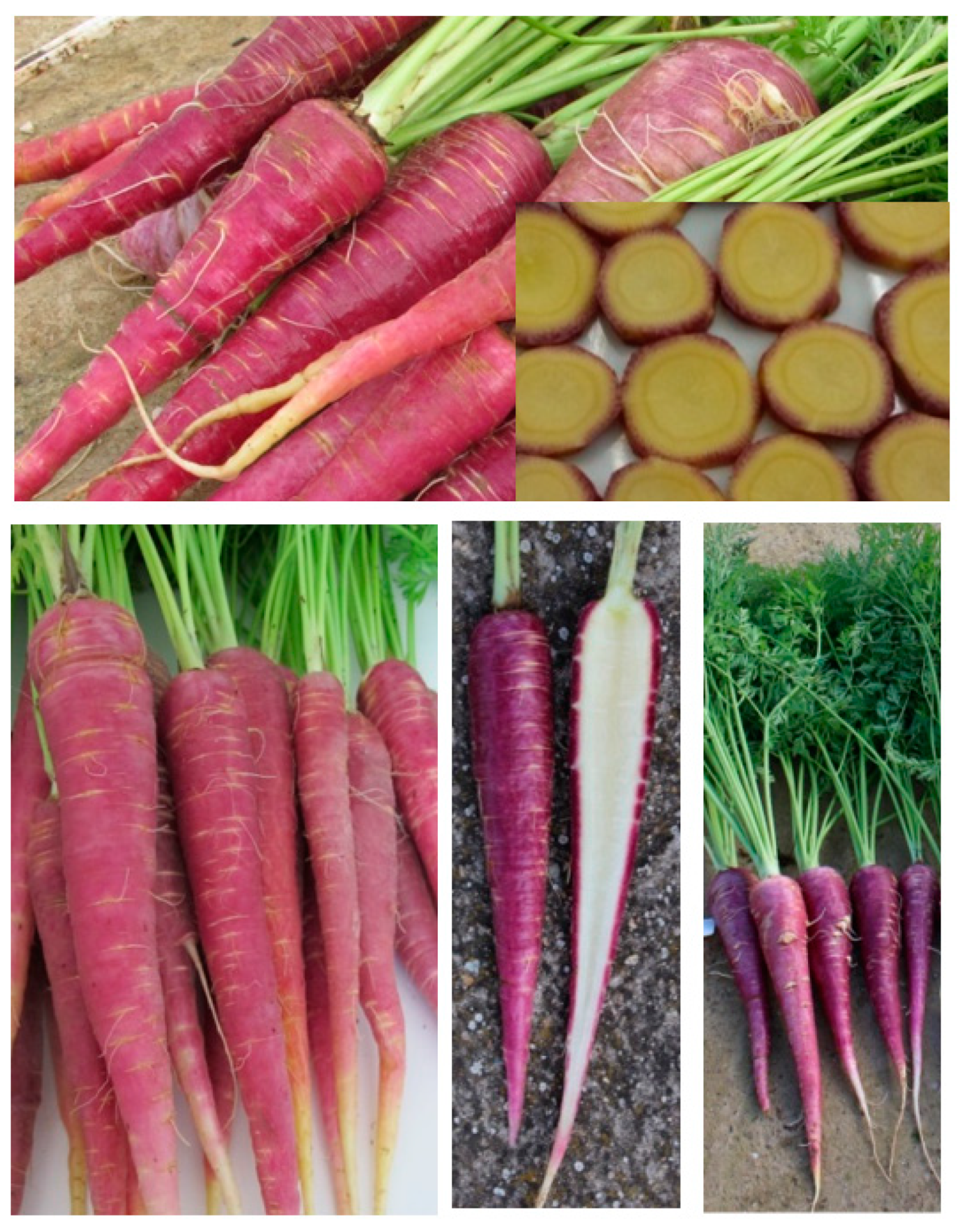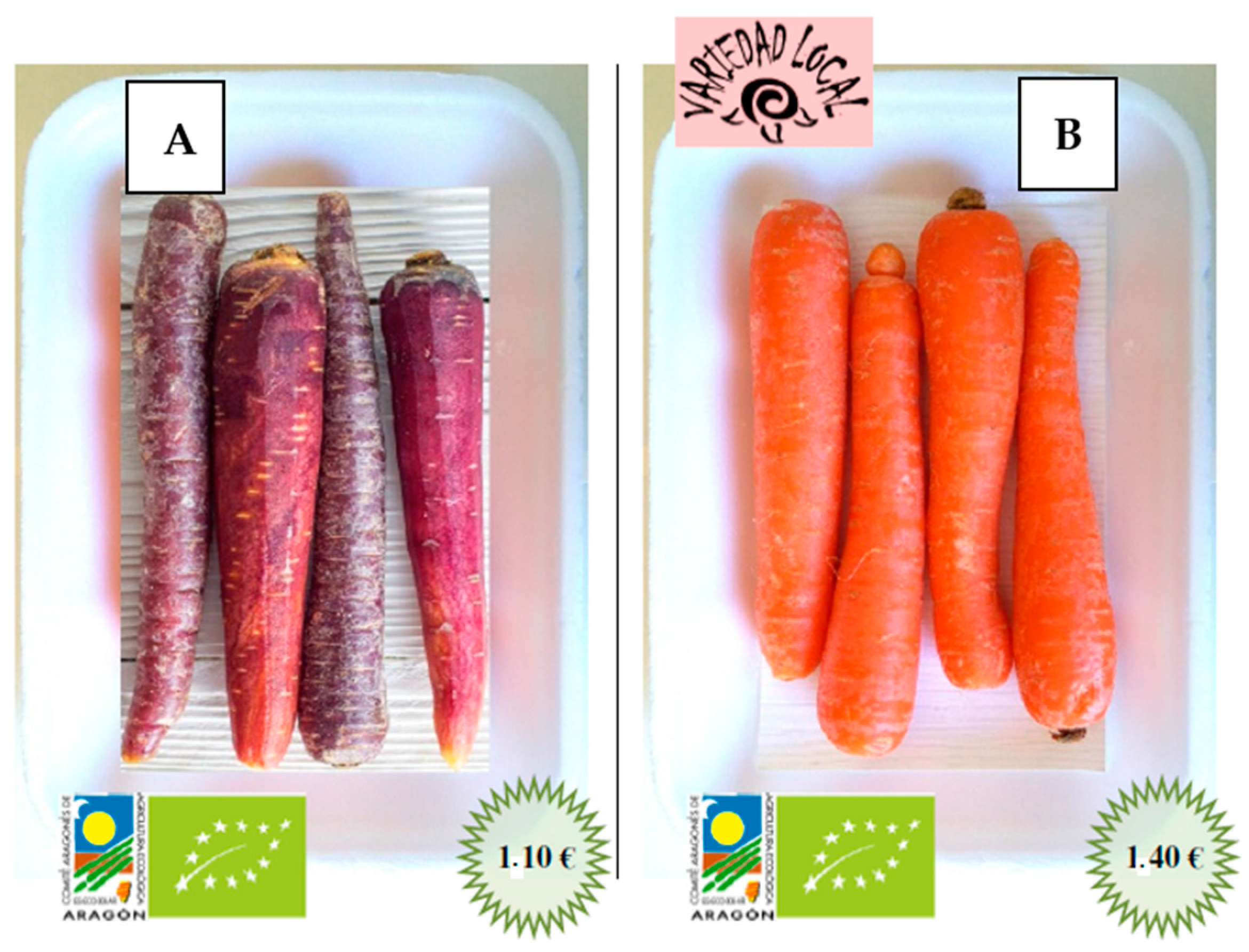3.1. Data Collection and Survey Description
Data were collected from an online survey conducted in the region where the local landrace was produced (Aragón) in July 2016. Consumers were stratified by gender, age, and the province of residence. The final sample size consisted of 405 people, resulting in a sampling error of ±5%, and a confidence level of 95.5% (k = 2) when estimating proportions for the more conservative scenario (p = q = 0.5).
Before the final questionnaire was distributed, a pilot survey was conducted with a sample of respondents (N = 15) to test general understanding and response time. The final questionnaire was structured into four parts. The first part contained questions related to consumers’ consumption and purchase habits regarding vegetables and carrots and on knowledge about carrots. In order to measure knowledge of carrots, an “objective knowledge” approach was used. Respondents were asked to indicate if five sentences related to carrots were true or false. The statements were: (1) carrots have vitamin A; (2) a carrot is a tuber; (3) carrots can only be orange; (4) carrots are high in antioxidants; (5) eating carrots helps preserve eyesight. Sentences (1), (4), and (5) are true, while sentences (2) and (3) are false. When an answer was correct, the sentence received the value 1, and the value of 0 when wrong. A summary index was created for the five sentences. Thus, the knowledge index ranged from 0 to 5. The second part asked respondents about the appeal of and their potential intention to purchase purple carrots after they were shown different pictures of purple carrots (whole and cut in slices) (
Figure 1). They rated how much they liked the appeal of purple carrots using a 9-point hedonic scale from 1 (extremely dislike) to 9 (extremely like).
In addition, we asked respondents about their intention to purchase the purple carrots using a scale from 1 (very unlikely) to 5 (very likely). Afterward, respondents received the following information “These purple carrots are from a local landrace from Aragón, more specifically, from Maestrazgo County (Teruel). These carrots are purple because they have different natural pigments”. Then, the two previous questions on the carrot’s appeal and the consumer’s intention to purchase were asked again to respondents. After that, participants received the following information “These purple carrots have high antioxidant content; thus, their consumption has health benefits for preventing cardiovascular and metabolic diseases”. The same two questions were again posed to participants. The third part consisted of the choice experiment task described in
Section 3.2 below.
Before the choice experiment questions, a description of the attributes and levels was presented to participants to ensure that they were aware of the alternative products. Participants were asked to read a cheap talk script to encourage and motivate them to reveal their real preferences and minimize potential hypothetical bias [
32]. Finally, questions on socio-demographic characteristics (i.e., age, family size, income, education level, and the province of residence) were included in the fourth part of the questionnaire.
3.2. Choice Experiment Design
First, we selected the product (half kilo package of carrots) and, second, the attributes and their levels.
Table 1 shows the selected attributes and their levels.
Besides the price, we selected the attributes of color (purple and orange) and the variety (local or non-local) based on our objective. Previous empirical studies on fresh fruits and vegetables have indicated that being organically produced is also an important product characteristic together with the local origin [
19,
20,
21,
22,
23,
31]. Thus, we selected the production system (organic or conventional) as an important attribute. The price levels were established based on the market prices at the time of the experiment: 0.5 €/package, 0.8 €/package, 1.1 €/package, and 1.4 €/package. The other three attributes had two levels: orange or purple for “color”; local or not local for “variety”; organic or conventional for “production method” (
Table 1).
The Street and Burgess [
33] approach was used to design the choice sets, which allows the estimation of the main and the two-way interaction effects between the color attribute and the other non-monetary attributes (variety and production method). With the 4 attributes with 4, 2, 2, and 2 levels, respectively, and 2 options, the design consisted of 24 combinations. To avoid having each participant respond to a high number of choice tasks, the total combinations were randomly split into six blocks. Thus, each respondent was asked to make four choices that included three alternatives: two designed alternatives consisting of different carrots (alternatives A and B) and a non-buy option. An example of a chosen card is shown in
Figure 2.
3.3. Model Specification and Estimation
The random consumers’ utility defined by Lancaster [
17] and McFadden [
18] was specified following a latent class (LC) choice model and estimated using NLOGIT 5.0. This utility of individual
n of the segment
s choosing alternative
j in the
tth choice occasion for the LC model was:
where
βs is the parameter vector of segment
s associated with the explanatory variables X
njt, and
are error terms that follow a Type I (or Gumbel) distribution. The choice probability that individual
n, conditional to belonging to segment
s (
s = 1, …, S), chooses alternative
i from a particular set
J, comprised of
j alternatives in a particular choice occasion
t, was represented as:
We assumed that the
tth choice occasions were independent [
34]; thus, for a given segment, the choice probability that individual
n, conditional to belonging to segment
s (
s = 1, …, S), chooses alternative
i from a particular set
J, comprised of
j alternatives, was represented as:
In order to derive a model that simultaneously accounts for choice and segment allocation, the probability that a randomly chosen individual
n chooses alternative
i was given by:
where
Pns is the probability of membership in segment
s.
Equation (4) was used to estimate the segment-specific utility and segment probabilities using a maximum likelihood method.
To determine the best number of segments, we calculated the Akaike information criterion (AIC), the Bozdogan Akaike information criterion (AIC3), the Bayesian information criterion (BIC), and the Akaike likelihood ratio index
for different segment specifications:
where
LL is the log-likelihood at convergence,
p is the number of parameters,
N is the number of observations (
N = 1620), and
LL(0) is the restricted log-likelihood. The preferred specification should be the one with the lowest AIC, AIC3, and BIC and the highest
[
35]. In addition, the optimal number of segments was selected by assessing whether additional segments provide any further information, with the overall aim of attaining segment parsimony, according to Swait [
36]. We stopped looking for further segments when the model started to deteriorate, meaning when much larger standard errors appeared, as suggested by Louviere et al. [
37].
In our empirical application and for the selected attributes and levels, the utility function (Equation (1)) was defined as follows:
where
n is the number of respondents,
j the alternatives (A, B, and the non-buying option),
t the number of choice sets, and
s the number of segments. The parameter
β0 is the coefficient associated with the alternative-specific constant that considers the value 1 for the non-buying option and the value 0 otherwise (i.e., for alternatives A and B). The price variable (
PRICE) was defined by the price levels in the design (
Table 1). The attributes of color, variety, and production method were represented by dummy variables
PURPLE,
LOCAL, and
ORG, where 1 indicated purple, local, or organic carrots, and 0 indicated orange, non-local, and conventional ones. Finally, interactions between the color and the other two non-monetary attributes were also calculated by multiplying the dummy variables (
LOCAL*
PURPLE, and
ORG*
PURPLE). These interactions are named, since now, as
LOCAL*
PURPLE, and
ORG*
PURPLE.
To test the overall statistical significance of the model, we calculated the likelihood ratio (LR) between the log-likelihood of the model at convergence and the restricted log-likelihood as:
To measure the consumers’ importance ranking for the different attributes levels, importance scores (IS) for each attribute were calculated, according to Chang et al. [
38], as follows:
where
k ranges from 1 to 6 (coefficients in Equation (9)); (Highest-Lowest) is the difference between the highest and lowest value of each attribute level.
From the estimated parameters, the marginal WTP for
PURPLE,
LOCAL,
ORG and for the interactions
LOCAL*
PURPLE and
ORG*
PURPLE was calculated as follows:
where
m ranges from 2 to 6.
The marginal WTP is the price change associated with a change in a given attribute, which represents the extra price consumers are willing to pay for each attribute. In addition, the total marginal WTP, accounting for both the main and interaction effects, was calculated, according to Merritt et al. [
39], as follows:









